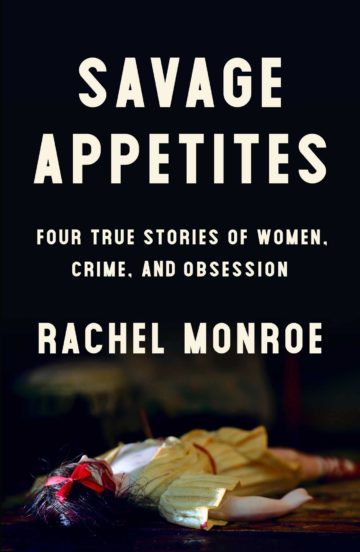
What Does Our Fascination with True Crime Say About Us?
Rachel Monroe’s Savage Appetites asks why true-crime stories are so popular, even while they risk exploitation.
True crime has never been more popular. The 2014 hit podcast Serial ignited a burgeoning genre whose recent entries include Netflix shows (Making a Murderer, Unbelievable), books (I’ll Be Gone in the Dark, Bad Blood), and countless podcasts (Doctor Death, based in part on a Texas Observer story; My Favorite Murder, Criminal, S-Town). Meanwhile, crime rates have fallen to record lows. So why is our desire for grisly stories so insatiable?
That’s the question the West Texas writer Rachel Monroe explores in Savage Appetites: Four True Stories of Women, Crime, and Obsession. In a genre she calls “meta-true crime,” Monroe recounts the obsessions of four women as a way to explore complicated questions about morality, identity, race, and class. Three of her characters are white, and one is biracial; Monroe notes that white women, herself included, seem especially drawn to true crime, perhaps because white female victims get so much airtime in the media.

by Rachel Monroe
Simon & Schuster
$26; 272 pages
Buy the book here.
That “true crime creates a narrative out of chaos” is a given. But in Savage Appetites, the pleasure comes from the way Monroe works backwards, untangling the neat, tidy surface stories of her four subjects and embracing the nuance, messiness, and all-important context that an exploration into female desire requires. These women are imperfect, “immoderate and occasionally unwise,” complex in a way that the dead bodies at the center of most true crime narratives rarely are.
First, there’s Frances Glessner Lee, “The Detective,” who in the late 1800s, the early days of forensic science, created miniature crime scenes. From Monroe’s telling, she was pushy and exacting, a woman who refused to stay in her socially sanctioned lane and lapped praise from police, who dubbed her “the mother of forensic investigation.” Lee’s meticulous crime-scene dioramas are still used in forensic training seminars today; Monroe explores how they put a subversive spin on traditionally feminine activities like sewing, crafting, and building dollhouses. As the sole non-contemporary woman Monroe investigates, Lee’s story lacks the didactic punch of the other three whose source materials—internet message boards, online chat logs, videotapes—feel more immediately relatable to the current true crime ecosystem.
One of the most compelling and troubling stories is that of Alisa Statman, “The Victim,” who became fixated on the 1969 murder of actress Sharon Tate by the Manson family. Statman moved into the Los Angeles home where Tate was murdered and befriended Tate’s sister. She then gained prominence as a victims-rights advocate and spokesperson for the tough-on-crime movement of the 1980s and ’90s. Monroe convincingly argues that this movement, stoked by the innocence and helplessness of white women and their overrepresentation in the media as victims of crime, “tapped into preexisting racial anxieties” and aligned perfectly with the rise in mass incarceration.
Lorri Davis, the subject of “The Defender,” married a man on death row and moved hundreds of miles from home, isolating herself from friends and family, racking up immense phone bills, raising legal funds, and becoming an outspoken, litigious advocate to free him. Her story, necessarily linked to her husband, Damien Echols, serves as a parable for would-be internet sleuths. In the early days of the true crime web, Echols’ supporters blamed another innocent man in his stead, proving the fallibility of online forums’ groupthink. (DNA evidence exonerated Echols in 2011.)
With skill and subtlety, Monroe shows that “random violence casts a long shadow” and that our obsession with it has a place in creating that darkness.
And in the final section, “The Killer,” Monroe wrestles with the chat logs of Lindsay Souvannarath, an “extremely online” young woman who fawned over the Columbine killers before plotting her own killing spree, complete with executioner’s outfit. (Luckily, she was caught just in time.) Monroe suggests there’s a thin line between Souvannarath’s crushes and our own obsession with mass shooters, fed by media coverage that inevitably leads to more mass shootings. She writes that “an alien landing on Earth might assume that we esteem these men” based on the amount of content we create and consume about them. In the same way that a heightened sense of victimization in the ’80s correlated with more imprisonment, the proliferation of stories on mass shootings has coincided with heavy policing of schools. Monroe smartly sees the increased surveillance in schools as an echo of “broader broken-windows policing” nationwide and as a general effect of the protect-the-innocent at all costs sentiment that the consumption of crime-related media engenders.
The differences in these women’s circumstances allow the book to function as a history lesson—one that centers women—as well as an investigation, leading the reader through the introduction of forensics, the victim-rights movement, the satanic panic of the 1980s, the introduction of Court TV and true crime on the internet, and the founding of the Innocence Project to elucidate how we got to the current moment in true crime, a moment when the backlash may finally be brewing. This critical context is the result of in-depth research and interviews with many of the book’s key figures, which Monroe weaves together with personal stories that clarify her own relationship with violence and crime.
Inevitably, binging leads to a stomachache. Monroe’s book leaves one with such a feeling. With skill and subtlety, she shows that “random violence casts a long shadow” and that our obsession with it has a place in creating that darkness.
Monroe concedes that not all mysteries get solved, including the question of why we’re all so fascinated by true crime. Maybe there isn’t an answer. But as she shows in these four narratives, it is worth the investigation nonetheless.
In her final section, as Monroe considers the women she’s written about while attending a true-crime convention, Savage Appetites seems to take a step away from the author’s own obsession with salacious crime narratives. The reader is left with the clues she’s gathered and the insights she’s made, to pick up and turn over, to solve or to obsess over—sort of like a crime scene.
Read more from the Observer:
-
As Pete Sessions Tries to Revive his Political Career, He May Get Sucked into Ukraine: The once-powerful Republican congressman is trying to claw his way back to Washington at a time when his allies in Trumpworld are under fire.
-
The Private Prison Industry (Finally) Faces an Uncertain Future: Traditionally, for-profit jailers have drawn bipartisan support. But Trump, the sector’s ostensible savior, has made the industry a lightning rod.
-
Who Is John Cornyn Serving?: The senior senator from Texas has mastered the art of political subservience, making him very powerful—and perhaps vulnerable.


